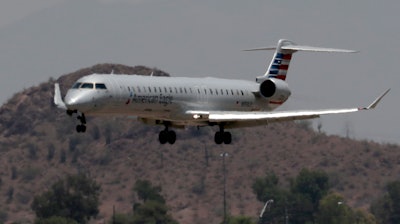
PHOENIX (AP) — Airlines canceled flights in Phoenix and doctors urged people to be careful around concrete, playground equipment and vehicle interiors Monday as a punishing heat wave threatens to bring temperatures approaching 120 degrees to parts of the Southwestern U.S.
Arizona is seeing the most stifling temperatures, but the wrath of the heat wave is being felt across Nevada and California as well. Las Vegas was forecast to hit 117 (47 Celsius) on Tuesday on the first day of summer, and excessive heat warnings cover almost all of California.
Despite the dangers, the weather may not be as bad as originally expected. The National Weather Service had been forecasting Tuesday highs at 120 or higher in Phoenix for the past several days, a number not seen in the desert city in more than 20 years, but it now predicts 119.
"That's deadly heat no matter how you slice it," weather service meteorologist Chris Breckenridge said. Here are a few things to know about the heat wave.
Airlines Watching the Heat
When the temperature soars, it's harder for airplanes to take off. American Airlines canceled nearly 40 flights on Tuesday in Phoenix operated by regional jets because of the heat. The airline also said it will allow Phoenix passengers flying during the peak heat Monday through Wednesday to change flights without a fee.
American Airlines spokesman Ross Feinstein said the smaller regional jets flown by its partners can't operate once the temperature hits 118. That maximum is set by Bombardier, the manufacturer. Larger airliners made by Boeing and Airbus have higher maximum operating temperatures, but airlines still need to closely monitor the weight of the jets during the heat.
Feinstein said the carrier began limiting sales on some flights to prevent the planes from exceeding maximum weight for safe takeoff in the hot conditions. Airlines can use other strategies for limiting weight during hot weather, such as not fueling completely, then making a refueling stop.
Burn Risks
It gets so hot in Phoenix that stores put coverings over door handles so people don't burn their hands. Steering wheels and car shifters can be too hot to touch when getting into a car. And the pavement can burn the paws of pets.
The director of the Arizona Burn Center said second- and third-degree burns from touching hot items are common in the extreme heat. Dr. Kevin Foster warned people to be extra careful around concrete, car interiors and playground equipment, especially young children who have sensitive skin.
Pavement and concrete can be dangerous for pets, Foster said.
Health Hazards
The county that is home to Phoenix had 130 heat-related deaths in 2016, the highest number in more than a decade. The Arizona Department of Health Services says nearly 2,000 people visit Arizona emergency rooms every year because of heat-related illnesses. Homeless people comprised one-third of heat-related deaths in 2016, according to county records. Most of the others involved people with non-functioning air conditioners.
Kurt Dickson, an emergency room doctor at Banner Health in Phoenix, said people have a range of heat illnesses during the summer months, including fatigue, heatstroke and severe sun burns.






















